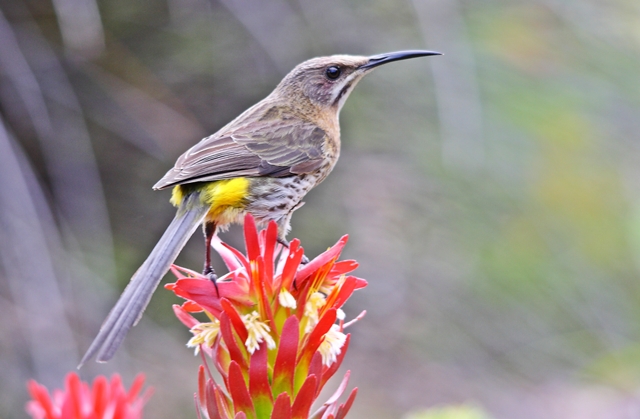Order: Proteales. Family: Proteaceae
 © Flutterby
© FlutterbyKirstenbosch, Cape Town
The genus Mimetes can readily be distinguished from all other Proteaceae by the dense heads of flowers formed by aggregating tubular, axillary, stalkless inflorescences (technically a pseudanthia), each containing 3-22 (35) florets and subtended by a leaf, into a large cylindrical inflorescence (technically a conflorescence). The perianth segments are almost entirely free and symmetrical. The style is hairless and is adorned by a distinctively-shaped pollen presenter in each species. Leaves are 1-3 toothed. The fruit is ovoid to cylindric, usually hairless to minutely hairy, with a prominent elaiosome at both ends joined by a thin ridge down one end.
Description
A densely-leaved shrub, 0.5 to 2 m tall with an upright, bushy growth habit. Multiple stemmed arising from a large subterranean rootstock. The hairless leaves are oblong-elliptic, 25-55 mm long and are neatly and symmetrically arranged along the branches. It has spoon-shaped red inflorescence leaves; the flower spikes comprise headlets of 4-7 white flowers surrounded by small bracts; the style is red and 45-50 mm long. Involucral bracts surrounding pseudanthia (axillary inflorescences) asymmetrical so that the lower lip of pseudanthia tube is longer than the upper lip, each pseudanthia is partially enfolded by the leaf above.
In Mimetes the flowers are grouped into small dense cylindrical inflorescences of 3-16 florets produced in the axil of a leaf, and up to 15 of these cylindrical inflorescences can occur on one flowering stem. Looking at Mimetes cucullatus we see wool-like tufts sticking out from between brightly coloured leaves towards the tips of the branches. Each 'tuft' is a group of 4-7 florets, the cylindrical inflorescence, and each inflorescence is produced directly below a leaf, which in this species partly encloses the inflorescence, like a hood. The actual inflorescence is not particularly showy, but the whole flowering stem is very colourful: the leaves that enclose the inflorescences are red at the tip, shading to a bright yellow and then into bright green. The creamy white 'tufts' are actually the bearded tips of the thread-like perianth segments and hold the anthers; and the styles are dark red, tipped with yellow and rear up right underneath the red hood-like leaf. Flowers are produced nearly all year round, but the peak flowering season is from early spring to late summer-autumn (August to March). Seeds are released 2-6 months after flowering.
Distribution
South African endemic (Eastern Cape, Western Cape). Mimetes cucullatus is the most widespread of all the mimetes. It occurs from the Koue Bokkeveld Mountains to Kogelberg to Elim Flats, Caledon Swartberg, Cape Peninsula; Potberg; Riviersonderend Mountains, eastern Langeberg to Outeniqua and Kouga Mountains; Klein Swartberg and Rooiberg.
Habitat
It is found on sandy soils, on sandstone slopes and flats, most frequently on the cool, moist, south-facing slopes and damp flats. It grows from sea level to 1 200 m.
Links: Protea Atlas; Field Guide to Fynbos. John C. Manning



 © arks
© arks © arks
© arks